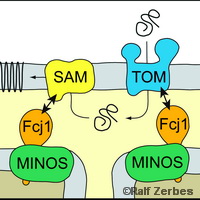European scientists realise new insight into the structure of mitochondria
New research conducted by a team of scientists led by Dr Martin van der Laan at the University of Freiburg, Germany have attained new and advanced insights into the structure of mitochondria. Mitochondria are often described as the microscopic power centres of cells. While they have the same size as bacteria, they are capable of harnessing the energy stored in food and in turn provide the energy a cell needs to move, divide and produce secretory products - in short, enabling essential life functions. The energy conversion occurs in delicately formed cavities that exist in the biological membranes inside mitochondria. Any defects that appear in these fine membrane structures can lead to severe diseases of the muscles and the central nervous system. A sophisticated molecular machine of the inner membrane that the Freiburg team discovered in 2011 is not only responsible for forming the characteristic structures within mitochondria, but evidently also plays an important role in assembling the outer membrane enclosing these organelles, as the scientists now report in the renowned journal Molecular Biology of the Cell. The protein machine studied by the scientists is essential for maintaining the typical architecture inside the mitochondria and as a consequence has been called the 'Mitochondrial Inner Membrane Organising System' (MINOS). According to their latest study, the Freiburg researchers and their colleagues in Graz, Austria, Groningen, Netherlands and Warsaw, Poland demonstrate that the role of MINOS in creating the mitochondrial architecture is clearly more extensive than previously assumed. In a joint research effort between the Collaborative Research Center 746 and the Cluster of Excellence Centre for Biological Signalling Studies (BIOSS), Dr Maria Bohnert, Lena-Sophie Wenz and Ralf Zerbes found out how MINOS connects the distinct membrane systems of the mitochondria with each other. The membrane complexes SAM and TOM play a key role in this process. They use tunnel-shaped structures to transport proteins into the mitochondrion and then embed them in the outer membrane. In their latest study, the Freiburg scientists demonstrate that the MINOS component Fcj1 of the Mitofilin protein family participates directly in this process, which is essential for the survival of the cells. The inactivation of Fcj1 inhibits the integration of proteins into the mitochondrial outer membrane. These findings show how molecular switches affecting the connectivity of mitochondrial membranes control the assembly and function of the cellular power plants. These newly gained insights improve our understanding of the basic principles of the architecture of mitochondria. In the future they could help scientists to understand and influence mechanisms of diseases that involve changes in the fine structure of mitochondria.For more information, please visit: University of Freiburg: http://www.uni-freiburg.de/start-en.html?set_language=en(opens in new window) Molecular Biology of the Cell: http://www.molbiolcell.org/(opens in new window)
Countries
Austria, Germany, Netherlands, Poland



